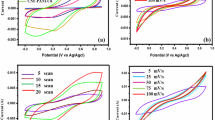Abstract
Developing a durable and scalable transparent conductor (TC) as an electrode with high optical transmission and low sheet resistance is a significant opportunity for enabling next generation solar cell devices. High performance fibrous composite materials based on a carrier polymer with embedded functional nanostructures have the potential to serve as a TC with high surface area that can be deposited by the novel and scalable process of electrospinning. This work presents the development of a fibrous TC, where polyacrylonitrile (PAN) is used as a carrier polymer for multi-walled carbon nanotubes (MWCNT) to create electroactive nanofibers 200-500nm in diameter. Once carbonized, thin layers of this material have a low sheet resistance and high optical transmission. It is shown that in a two stage carbonization process, the second stage temperature of above 700C is the primary factor in establishing a highly conductive material and single layers of nanofibers are typically destabilized at high temperatures. A high performance TC has been developed through optimizing carbonization rates and temperatures to allow for single nanofiber layers fabricated by electrospinning MWCNT/PAN solutions onto quartz. These TCs have been optimized for concentrations of MWCNTs less than 20% volume fraction with well above 90% transmissivity and sheet resistances of between .5-1kohm/square. The required MWCNT loading is well below that for TCs based on random networks of MWCNTs.
Similar content being viewed by others
References
“How Long Will it Last?”. New Scientist 194 (2605): 38–39. May 26, 2007.
J. Kalowekamo, & E Baker . (2009). Estimating the manufacturing cost of purely organic solar cells. Solar Energy, 83(8), 1224–1231. Elsevier Ltd. doi:10.1016/j.solener.2009.02.003
Glatkowski et al., “ Carbon nanotube transparent electrodes: A case for photovoltaics,” in Photovoltaic Specialists Conference (PVSC), 2009 34th IEEE, pp. 001302–001305, 2010.
A. A. Green, & M. C Hersam . (2008). Colored Semitransparent Conductive Coatings Consisting of Monodisperse Metallic Single-Walled Carbon Nanotubes. Nano Letters, 8(5), 1417–1422. doi:10.1021/nl080302f
S. De, P. E. Lyons, S. Sorel, E. M. Doherty, P. J. King, W. J. Blau, P. N. Nirmalraj, et al. (2009). Transparent, Flexible, and Highly Conductive Thin Films Based on Polymer−Nanotube Composites. ACS Nano, 3(3), 714–720. doi:10.1021/nn800858w
S. L. Hellstrom, H. W. Lee, & Z Bao . (2009). Polymer-Assisted Direct Deposition of Uniform Carbon Nanotube Bundle Networks for High Performance Transparent Electrodes. ACS Nano, 3(6), 1423–1430. doi:10.1021/nn9002456
F. K. Ko, & H Yang . (2008). Functional Nanofibre: Enabling Material for the Next Generations Smart Textiles. Journal of Fiber Bioengineering and Informatics, 1(2), 81–92. doi:10.3993/jfbi09200801
H. Hou, J. J. Ge, J. Zeng, Q. Li, D. H. Reneker, A. Greiner, & S. Z. D Cheng . (2005). Electrospun Polyacrylonitrile Nanofibers Containing a High Concentration of Well-Aligned Multiwall Carbon Nanotubes. Chemistry of Materials, 17(5), 967–973. doi:10.1021/cm0484955
Author information
Authors and Affiliations
Rights and permissions
About this article
Cite this article
Ritchie, J., Mertens, J., Yang, H. et al. Electrospun Composite Nanofiber Transparent Conductor Layer for Solar Cells. MRS Online Proceedings Library 1323, 348 (2011). https://doi.org/10.1557/opl.2011.829
Published:
DOI: https://doi.org/10.1557/opl.2011.829




